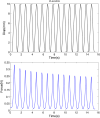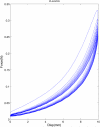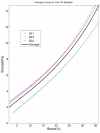Vocal fold elasticity in the pig, sheep, and cow larynges
- PMID: 20137893
- PMCID: PMC2888685
- DOI: 10.1016/j.jvoice.2009.09.002
Vocal fold elasticity in the pig, sheep, and cow larynges
Abstract
Elastic characteristics of the pig, sheep, and cow vocal folds were investigated through a series of in vitro experiments. Sample strips of the vocal-fold tissue were dissected from pig, sheep, and cow vocal folds and mounted inside a saline-filled ergometer chamber that was maintained at 37°C ± 1°C. Sinusoidal elongation was applied on the samples to obtain the passive force measurements. Force and elongation data from the samples were recorded electronically with a dual-servo system (ergometer). Stress-Strain data were compared to characterize the interspecies differences in the elastic properties of vocal folds. Pig vocal folds exhibited the most nonlinear stress-strain relationship, indicating the presence of a high level of collagen fibers. Cow vocal folds had the highest Young's modulus, but the tissue displayed a nearly linear stress-strain profile. Previous studies of phonation in these three species have indicated that pig larynges have the highest range of phonation frequencies, making them a good candidate for animal studies. The current study provides quantitative data for the elastic properties of the oscillating laryngeal tissue in these species and indicates that nonlinear behavior of these tissues may lead to wider oscillation ranges.
Copyright © 2011 The Voice Foundation. Published by Mosby, Inc. All rights reserved.
Figures










References
-
- Kurita S, Nagata K, Hirano H. A comparative study of the layer structure of the vocal fold. In: Bless DM, Abbs JH, editors. Vocal Fold Physiology: Contemporary research and clinical issues. College Hill Press; San Diego, CA: 1983. pp. 3–21.
-
- Kim MJ, Hunter E, Titze IR. Comparison of human and ovine laryngeal dimensions. Annals of Otology, Rhinology and Laryngology. 2004;113:60–68. - PubMed
-
- Alipour F, Titze IR. Elastic models of vocal fold tissues. J Acoust Soc Am. 1991;90(3):1326–1331. - PubMed
-
- Alipour F, Titze I. Active and passive characteristics of the canine cricothyroid muscles. Journal of Voice. 1999;13(1):1–10. - PubMed
Publication types
MeSH terms
Substances
Grants and funding
LinkOut - more resources
Full Text Sources

